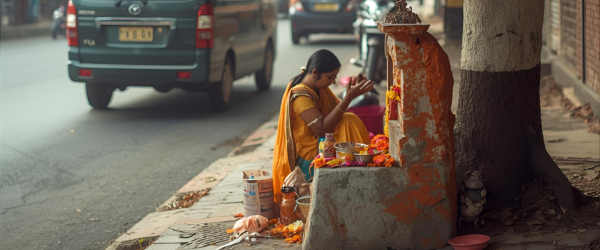Why Roadside Shrines Are More Than Just Altar | Sacred Structures & Community Hubs

Neatly tucked away beneath a tree or embedded into a wall, decorated by a garland of pink and yellow flowers, lies a humble wayside shrine, its bright blue paint chipping off at the edges after years of devotion. Next to it a flower seller sets up shop, selling fresh jasmines, roses and marigolds, their fragrance filling the shrine. A woman offers a quick prayer before heading for work.
Wayside shrines, also commonly called roadside shrines, are religious images or small temples erected in public spaces, usually on sidewalks, highways, under trees, or built into walls. The cropping up of a roadside shrine is not an uncommon occurrence on the streets of India; one can find such places of worship turning up around every corner.
Shrines That Emerge from the Everyday
Roadside shrines dot the map of India like stars in the sky; you could walk past a sidewalk every day until one day you might find yourself having to jostle past a group of devotees surrounding a new shrine that showed up the night before.
More often than not, shrines of this nature do not experience an elaborate construction; their existence stems from materials laying around– a few red bricks, a broken tile, a piece of wood or a big rock– they all have the potential to pass off as a shrine. This remains to be one of the key features of roadside shrines in India: a simple stone can turn into a sacred shrine when marked by vermilion. Devotees also leave offerings such as flowers, coconuts and bangles, sometimes even tying a thread around the tree next to the shrine. One interesting shrine I came across appeared as a golden trident propped up in front of a tree by the sidewalk, set against the rush of passing traffic.
Despite having lived in Chennai for the majority of my life, it was only a year back that I really noticed wayside shrines in the city. I began a side-quest trying to spot all the roadside shrines that lined my way to work, and I will admit that it was a fun hour. I spotted 11 shrines, and almost each shrine was different from the next. One was propped up on a wall and secured with a grill, while another almost took the form of a mini temple. Fences and grills mark the shrine as a separate space, protecting their sanctity.
The construction of a new shrine on the sidewalk also seems to be the cue for vendors to set up shop. In that sense, multi-functionality becomes a characteristic of roadside shrines. It’s also fascinating the way shrines seem to magically appear. During an unusually early walk to work, I noticed a shrine standing right outside the street. Two priests were performing the morning rituals, a puja thali in hand. What struck me was that a street I had begun to know like the back of my hand had a shrine hidden in plain sight. Or perhaps it was just my obliviousness to my surroundings.
Wayside shrines are the humblest of sacred symbols. Perhaps their grandeur stems from their modest nature. One of the most telling features of a roadside shrine is that people don’t cut things around a shrine to build it– it carves its own space in the midst of nature, buildings, and streets.
In this sense, wayside shrines can also be considered as artefacts of visual culture. Nirmala Beluka, in her paper titled ‘Making of the Deity’: The City and its Visual Culture,’ highlights this idea. She questions the possibility of viewing roadside shrines as being beyond mere spaces for religious and social practice, and providing a deeper understanding of the city and its visuality. It’s a fair argument; I, too, reckon that Indian cities would be incomplete without their roadside shrines.
Shrines as Community Anchors
Another striking feature is that wayside shrines also act as community hubs and expressions of everyday religiosity, blending religious structures with the urban landscape. In that way, these shrines serve as focal points for local communities. It is the accessibility that these shrines offer that make them so popular in the semi-urban landscape.
A detour from my usual route led me to a shrine where an evening puja was underway. The shrine was bigger and more nuanced than your average roadside shrine– a mid-sized shrine, if you will. A group of ladies outlined the temple walls that were bordered with a metal grill, offering their prayers and chanting mantras for a good life. This is the evening ritual of millions of Indians, integrating such shrines into the fabric of their daily lives.
Urban spaces also highlight the dynamic nature of wayside shrines: new elements can always be added or removed with time, or shrines might completely be lost to urban development and planning. One may also consider wayside shrines to be an indicator of working-class religiosity in the country. A quick prayer, a rushed offering, and a … on the way to work speaks volumes about the
Roadside shrines, in a way, also allow devotees to honour local deities, building a dedicated space for them. However, it is important to note that these shrines are not bound by any particular religion. Catholic shrines are typically found in Kerala and Goa, and small dargahs are situated across the country.
In 2009, the Supreme Court passed a judgment banning the construction of new religious structures, including roadside shrines. The law aimed to curb encroachment on public spaces and prevent obstruction of traffic. However,
The Motorcycle God and Other Oddities
India is layered with examples of wayside shrines that transcend geographies, with interesting backstories and odd deities. The deification of objects and people is a phenomenon much too common in this country.
In 1988, Om Singh Rathore, a local Rajput, died in a motorcycle accident near the Jodhpur – Pali highway. What followed was no less than a miracle. The motorcycle, a 350cc Royal Enfield Bullet, was taken to the local police station but mysteriously returned to the accident spot. Despite being taken away, the bike repeatedly returned to the crash site, leading locals and the police to believe that it was possessed with supernatural powers. What followed was hardly a surprise. Locals built a shrine at the crash site, which has now evolved into a renowned roadside temple where travellers and truck drivers stop to seek blessings for a safe journey. Thus, an ordinary motorist turned into a folk deity on a highway in Rajasthan.
In the village of Talhan in Punjab is a temple now called the Gurudwara Talhan Sahib. Initially a shrine built in the memory of Baba Nihal Singh, a revered saint in the village, the Gurudwara has a tradition of devotees offering toy airplanes in the hopes of starting a new life abroad.
The history of shrines in India is rich with many such stories of valour, superstitions and beliefs, cementing the past and its people in sacred structures.
Wayside Shrines in Global Cultures
Wayside shrines, however, are not exclusive to India. They can be found in many countries across the world, having been a feature of Chinese, European, and other Asian cultures. Slovenia’s chapel-shrines, Germany’s ‘spoon’ shrines, or Schöpflöffel shrines, Austrian column shrines, and Greece’s modest shrines, known as kandilakias, stand as everyday markers of devotion.
In some Polish neighbourhoods, shrines from the First World War still exist, serving as a space for religious devotion for the surrounding community. Europe, Mexico, and some parts of the United States and Canada have shrines lined along roads and sometimes even private property. Just like in India, these shrines also come in various styles, from simple wooden crosses and small towers to tiny chapels and niches in walls.
In an article published by the Smithsonian Center for Folklife and Cultural Heritage, Chela Aufderheide writes, “Shrines make a community’s history present in a tangible way, telling stories which sometimes interact with a broader national narrative but are always local and often highly personal.” This is true of shrines of all nature, across the globe.
From the 6th to the 8th century, penitential crosses and shrines were erected across Europe, serving as acts of atonement, while also keeping the legacy of the victims alive. European and American shrines are mostly cenotaphic in nature, as they are often built to honour a person, making them a personal expression of loss and remembrance.
Roadside shrines are like magnets, attracting faithful devotees, tourists, and the occasional curious traveller. In the process of working on this story, I’ve turned spotting wayside shrines into a sort of game, and I’m almost always fascinated by each shrine.








